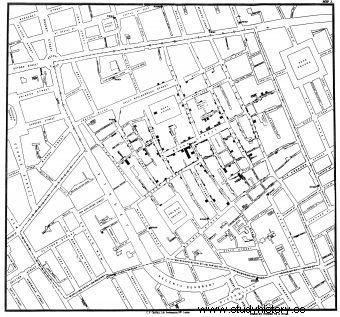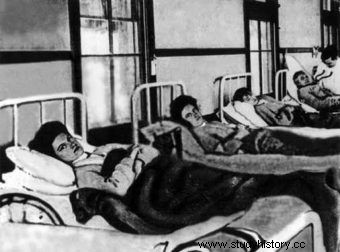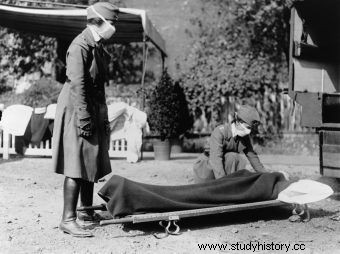Sloppy maid. An infant with diarrhea. Lonely elderly woman. Or ... a sneezing cook. One, often unaware, carrier was enough to infect dozens or even hundreds of people who passed the disease on. How is that even possible?
The years 1665-1666 were unlucky for the people of London. Not only was the city depopulated, it was soon ravaged by fire. Especially the first catastrophe could not be explained by the inhabitants. At that time, little was known about infectious diseases and the ways in which they spread.
So the supernatural forces were blamed, including the comet seen above the metropolis, or the natural, blaming the blame on ... Charles II Stuart, who, after numerous perturbations, took the throne of his lost father, Charles I. the overcrowded capital.
Plague under the Christmas tree
It all probably started on the frosty Christmas Eve of 1664, in the remote parish of St Giles-in-the-Fields, outside the walls of London. A group of elderly women went to the home of a parishioner named Philips, where they stated without a shadow of a doubt that she had died of the plague. And although the neighbors might have worried about this news, the city authorities not necessarily. From time to time in the registers there were mentions of deaths for the same cause. At the time, however, the plague was treated as an act of God. This is what a Spanish Catholic wrote about the English:
Puritans say that [the plague] cannot be avoided, that death from it [is grace], and that at least they stop [with this disease] , it will only touch those whom the finger of God points to [no matter what they do]. They also say that it must be so, and that madness is to try to protect yourself from it.

It was in St Giles-in-the-Fields Parish that the plague began and ravaged London. The photo shows the parish church.
The same author also added somewhat maliciously, but not without reason that if the epidemic breaks out, Londoners, even in spite of such fatalistic views, will surely flee the city.
On Christmas Day, 1664, no one would have imagined that the Day of Doom was approaching. Mrs. Philips' house was closed, windows and doors were killed, and the door read "Lord, have mercy on us." They wanted to warn passers-by about the air in the place.
Unfortunately, all for nothing. Until subsequent holidays, thousands of homes bore similar signs, and tens of thousands of people in and around London fell victim to the plague. An indirect effect of the plague was also the death of thousands of quadrupeds. As a result of the order of the mayor of London, from July 1665 all cats and dogs in the city were killed.
Death in the lining and "ghost map"
The Americans of the late nineteenth century, although they had only recently apologized with soap and water, quickly made everyday hygiene a national virtue and an integral part of the "American way of life". At least on paper, because in practice the slogans of keeping clean and tidy around oneself were not implemented everywhere.
Reports on the life of the poor in New York were provided by, among others, a photojournalist and reformer named Riis. In a book published in 1890 entitled "How the Other Half Lives ) he described seamstresses and seamstresses who worked in rented apartments. As he said, these were habitats of dirt and disease, even a ticking biological bomb:
Many times, a child recovering from smallpox and at its most contagious stage frolics among piles of half-finished clothes that land on the counter the next day some store on Broadway.

The book "How the Other Half Lives" described New York City tenement houses that had little to do with the national virtue of hygiene.
It happens that a typhus patient stays in a room from which maybe a hundred coats were sent to customers , everyone with a death sentence lurking somewhere in the lining.
Thanks to such customs, epidemics often took their toll. They spread throughout the neighborhoods. Of course, this was true not only of the New World, but also of Europe. In the now fashionable London district of Soho, in 1854 as many as half a thousand people died in less than two weeks! Vomiting, diarrhea, severe stomach aches and thirst left no room for doubt - cholera was out in the city center.
The death toll grew dramatically. More than 10,000 died by the end of the epidemic. The doctors were powerless until one of them, John Snow, took matters into his own hands. He did something unique and innovative for his time:he marked the deaths on a map, later called a "ghost map". The effect was clearly visible. It was mainly the people who lived near the Broad Street (today's Broadwick) water intake that died like flies.

John Snow's map, later known as the "Ghost Map", identified the source of the epidemic.
It turned out that the source of the infection was ... several months old Frances Lewis who lived on Broad Street. Her mother poured the water in which she had washed the nappies into the leaky sewage pit by the house. It poisoned a source of drinking water for thousands of people in the area . The case was resolved:the pump was sealed, and the epidemic was soon extinguished. Unfortunately, this was neither the first nor the last plague of a lethal infectious disease in the Victorian-era London.
Mary hang out, John got away with it
"Where people always have clean hands, there is little typhoid," said the well-known epidemiologist, Professor Marcin Kasprzak. Indeed, hygiene is a good measure to protect against one of the most dangerous infectious diseases in history. This rule was not followed by Mary Mallon, baptized by the Typhus press Mary. And since she worked as a cook, the risk was high.
As Mary Beth Keane writes in the novel "Fever" , based on Mallon's fate for the careless approach of the housekeeper to the issue of cleanliness, it paid with their health or life for half a hundred people. Not surprisingly, when authorities discovered the source of the disease, they found it a deadly threat to those who eat its food.

Mary Mallon's carelessness in maintaining good hygiene cost the health or lives of fifty people. Pictured is Mary Mallon during hospitalization (first from left).
As a result, Mary was forcibly placed under strict quarantine on North Brother Island by the New York City Department of Health in 1915. She spent the last 23 years of her life in solitary confinement as a so-called "asymptomatic carrier" of typhus, a person who infects without showing symptoms of the disease herself . She died in isolation on November 11, 1938. The obituary found her guilty of three deaths and over 50 cases.
Interestingly, at the same time there was a Yellowstone guide, dubbed "Typhus John" by journalists. It has been identified as the source of the typhoid epidemic among tourists in the region. It infected almost 40 people, two died. In his case, however, the state authorities concluded that there was no legal basis that could justify his isolation.
The authorities took an identical position in two similar cases in the 1920s. When two restaurant workers in New York proved to be carriers of typhus, they were quarantined for two weeks and then released. The judge stated that he could not, under the law, sentence such people to prison.

The story of "Typhus Mary" is described in the book by Mary Beth Keane "Fever" published by Wydawnictwo Literackie.
The newspapers reported that there could be as many as 10,000 similar cases across the country! It was believed that there was no way to stop them from spreading the disease. There is some point in this. According to modern statistics, as many as 5% of patients with typhoid fever may have no symptoms . With the number of 17 million cases around the world, this makes for quite a large group of people with whom it is better not to shake hands ...
Private Zarazek
Typhus, hell, plague - at the mere sound of these words, shivers go down your spine. Yet it is the innocent-sounding Spanish flu that has suffered tens of millions of victims. In 1918, when the world had not yet recovered from the nightmare of war, a third of the population fell ill out of nowhere. How did this come about?
First, it's important to understand how infectious diseases spread. In a book published a few years before the Spanish pandemic, he was introduced by a Polish doctor, Dr. Gantkowski. He enumerated:
The spread of infectious diseases is based on the fact that there must be carriers of bacteria, who transfer them from a sick person to a healthy person [...] We divide bacterial carriers into:
1 ) spreaders of convalescents, i.e. those who, after suffering a given infection, secrete pathogenic bacteria for a shorter or longer period;
2) healthy carriers who were not sick at all, but only, while being surrounded by patients, acquired the given germs and then spread them;
3) spreaders, "primitives", who spread bacteria around themselves during the brooding period of the disease.

The Spanish flu struck at the end of World War I. Pictured is Fort Riley, Kansas (USA) First Aid.
It is easy to see that Typhoid Mary, for example, was the second type, though no one would believe that she did not know about her illness. In the novel "Rush" Mary Beth Keane suggests that doctors examining the cook suspected of knowingly contaminating the cook during the quarantine. They might think she was too intelligent to be unaware of anything.
How was the post-war flu? It turned out that the source of the disease was a third type of vector. Interestingly, it was about the cook again. It was Albert Gitchell of Fort Riley, Texas.
It all started on Monday morning, March 11, 1918, with the most ordinary cough. Doctors isolated the patient immediately, but it was too late. The previous evening he had cooked dinner for the soldiers stationed at the base. By noon, a hundred recruits were in bed.
As death took its toll on the military, the virus left the base and spread rapidly across the US, Europe and along the front lines to the rest of the world. The conditions were perfect for this:Fort Riley was the base for troops sent to the Western Front. The germs were spread by those who had the flu already behind them, and by those who only got sick in the Old Continent. And maybe also those whom the Spanish woman did not like, because there are always some…

The flu quickly spread outside of Fort Riley. The photo shows two nurses during a pandemic (1918).
The epidemic, which only began to fade in the summer of 1919, was one of the deadliest in history. 500 million people became infected, which was then 1/3 of the world's population! The virus has reached Asia, Africa and the Antipodes. According to various estimates, between 20 and 40 million people died.
After a hundred years, scientists are still working hard to find out the exact causes of the plague that took a greater toll than the war that preceded it. To this day, influenza in its various forms is considered one of the most contagious diseases known to mankind. Complications after it kill up to 2 million people every year. But how can you protect yourself from it when you can catch it in just a few minutes with a health-looking host? For comparison - to contract tuberculosis, one needs to spend about 8 hours with the patient.
Bibliography:
- Katherine Ashenburg, The History of Dirt , Bellona 2010.
- Frederick Cartwright, Michael Biddiss, The unseen enemy. Pests and History , "Wołoszański" 2005.
- Samuel Pepys Diary , selection, translation and footnotes by Maria Dąbrowska, PIW 1954.
- Paweł Gantkowski, The essence of the plague and the view of the fight against infectious diseases in times of war , Printing House and Bookshop of St. Wojciech 1916.
- Mary Beth Keane, Rush , Wydawnictwo Literackie 2018.
- Lloyd Moote, Dorothy Moote, T he Great Plague:The Story of London's Most Deadly Year JHU Press 2004.
- Antoni Puławski, About the newest methods of preventing some infectious diseases, Drukarnia Krajowa 1918.
- Jacob Riis, How the Other Half Lives , Scribner's Books 1890.
- Jacques Ruffie, Jean Charcles Sournia, The history of the epidemic - from the plague to AIDS , W.A.B. 1996.
- Claire Sandoval-Peck, From “Destroying Angel” to “The Most Dangerous Woman in America”:A Study of Mary Mallons Depiction in Popular Culture , University of Washington Tacoma:History Undergraduate Theses 2016.
